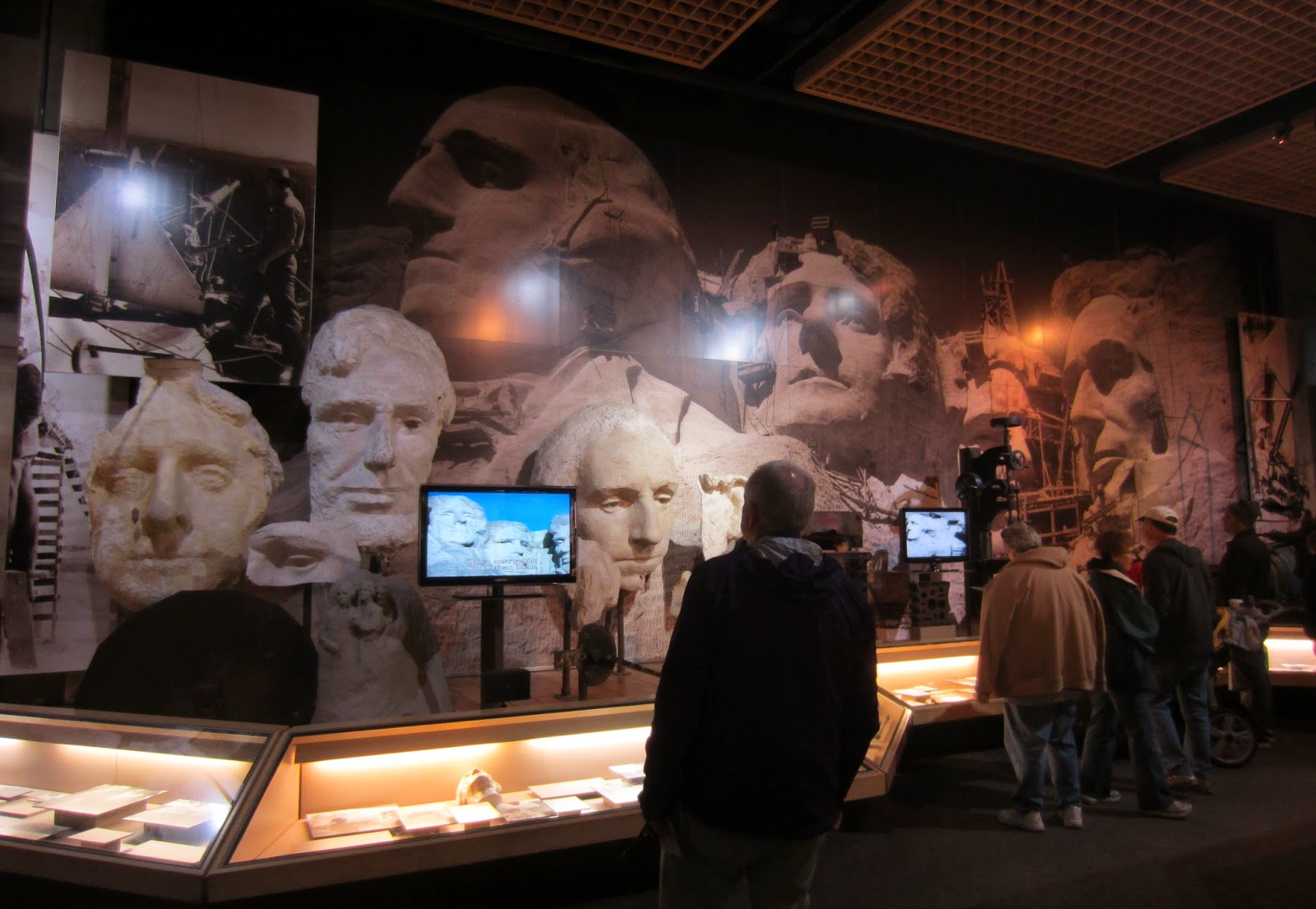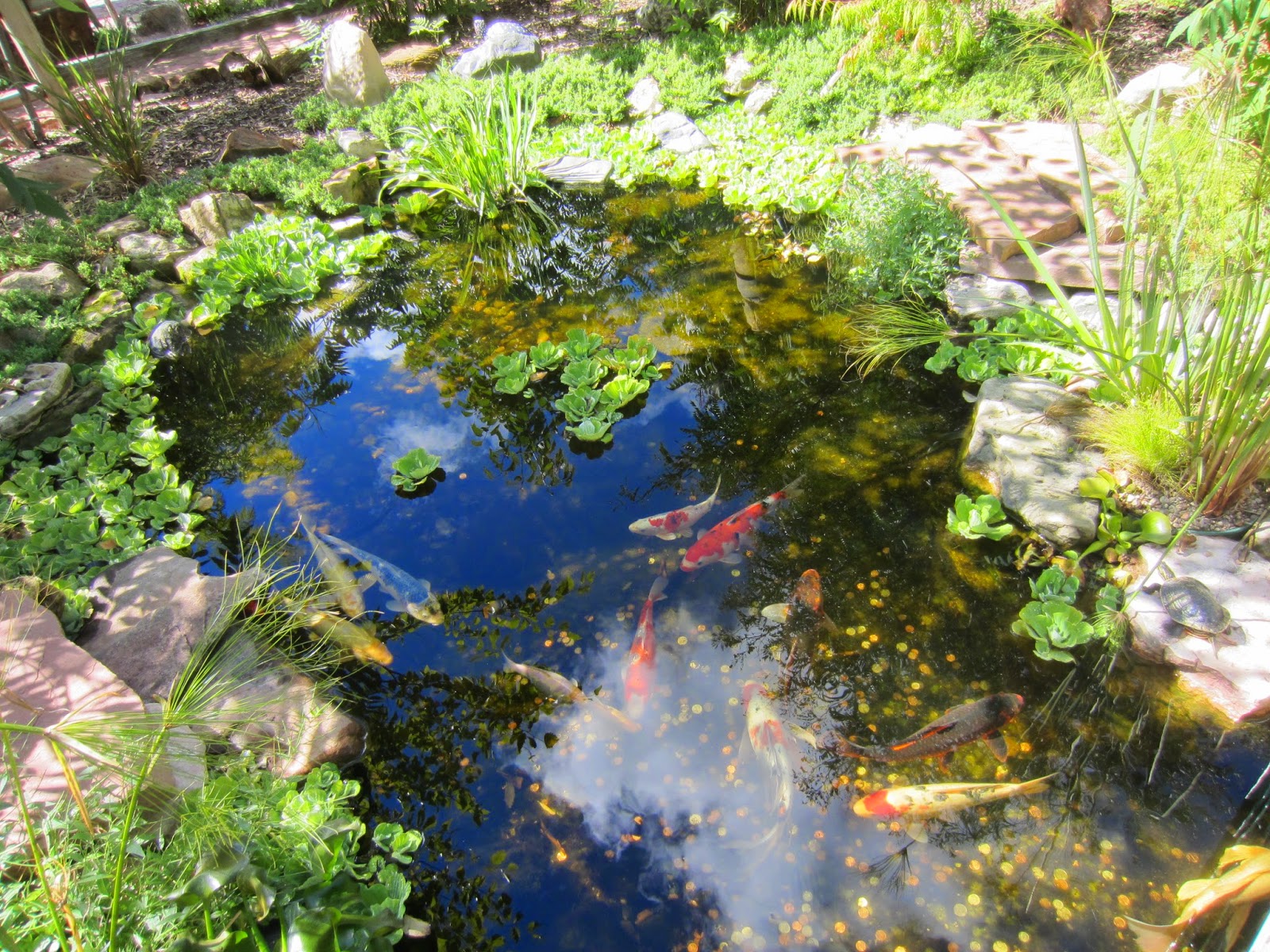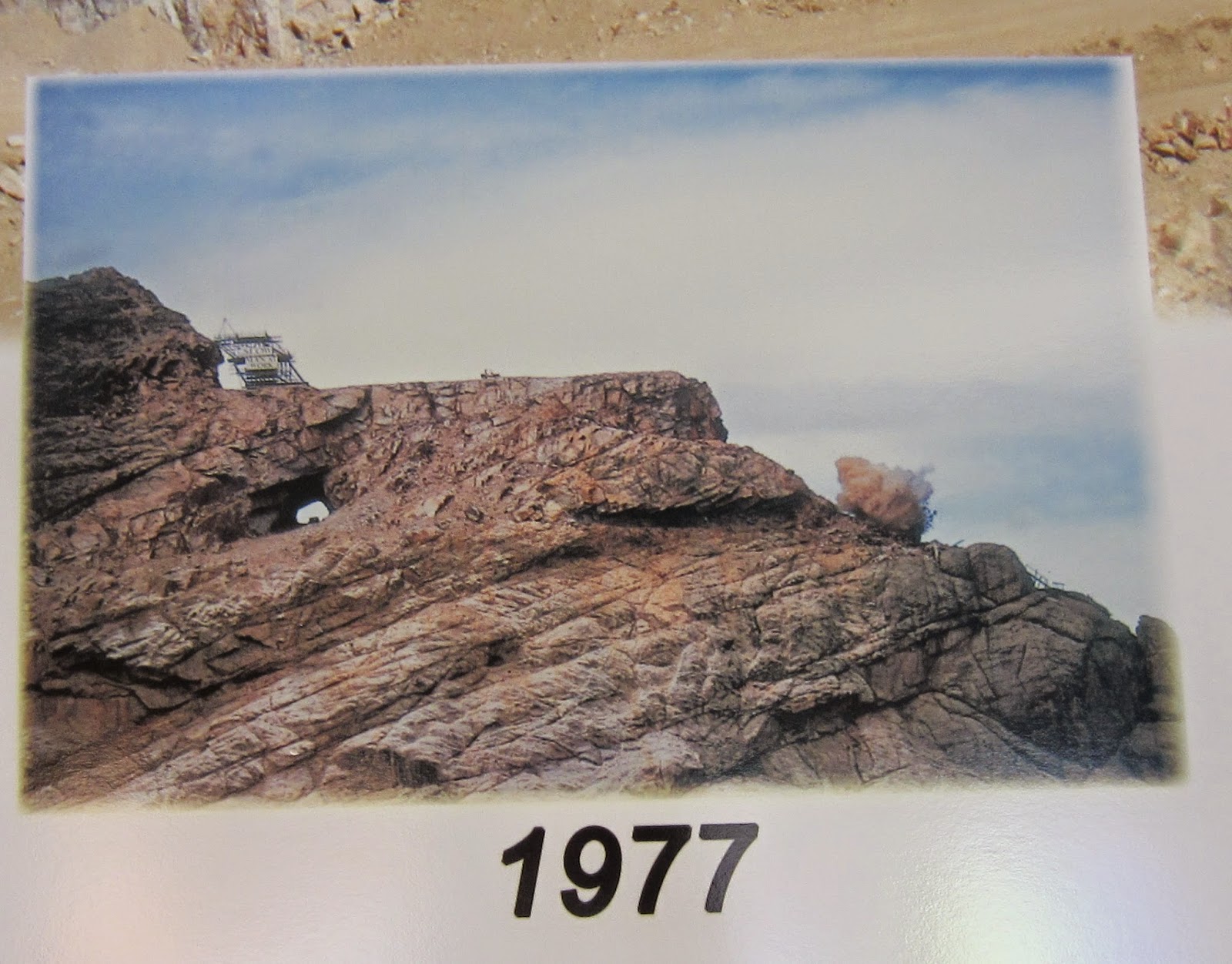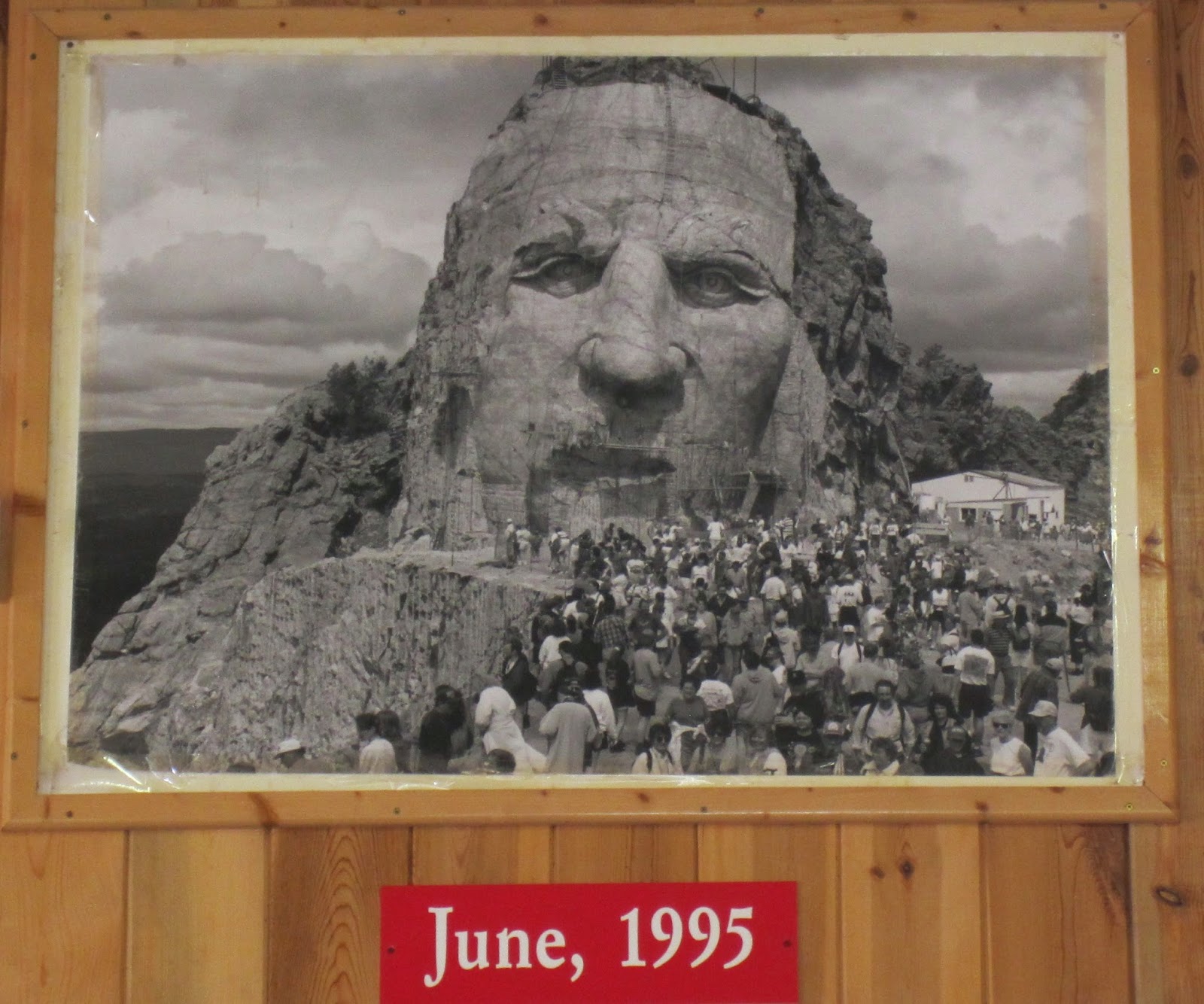We took a short trip to South Dakota in October because--well--just because. South Dakota was one of the unchecked states on my husband's Fifty States List. Honestly, I wasn't all that excited to go to South Dakota. The whole state has only 850,000 people, 3,000,000 fewer people than Los Angeles.
Besides, unlike my husband, I had been to South Dakota before. My family had driven through in 1975 and visited the three sites covered by this post. This time, Bob and I flew to Rapid City and rented a car. Our first stop was just 15 minutes from the airport.
1. REPTILE GARDENS
Unfortunately, we arrived in South Dakota a couple of days after the earliest snowfall in the state's history. Sadly, the "Gardens" part of Reptile Gardens had been drastically affected. There was substantial frost damage:
But other parts of the garden still looked pretty good:
These areas helped us imagine what the gardens look like at their peak:
We were really more interested in the animals anyway. This is Cheyenne the Bald Eagle, found in Nebraska with a broken wing and now a permanent resident.
These huge tortoises were the one thing I remembered from my visit 34 years before:
As you can see, the exhibits are quite a bit classier now than they were in 1975.
One newer exhibit is a prairie dog town.
There is an underground passageway that leads to above ground bubbles for up-close-and-personal looks at the little rodents:
There is also a nice reptile house, similar to a typical reptile house in a zoo: a central atrium with a circular hallway around it full of glass cages of critters.
There are tortoises, turtles, and frogs:
. . . lizards:
. . . and snakes, both very dead ones:
. . . and very live ones:
My favorite part was the orchid garden inside that center atrium of the reptile house:
As I noted earlier, I remember visiting Mount Rushmore in 1975, but for some reason it seemed so much BIGGER back then. The nice walk lined with state flags and the informative museum/visitor center wasn't there either, or if it was, it was much smaller.
Why these particular four Presidents? I had hoped you would ask:

In spite of the monument's perceived lack of size, the faces are 60 feet high, or the size of a six-story building. Washington's nose is 21 feet long, and the other three noses are 20 feet long. The eyes are 11 feet wide, and the mouths are about 18 feet wide. The figures are scaled to the size of a person who is 465 feet tall.
Yeah, it's big.
Stone carved away from the faces creates an impressive gravel waterfall beneath the four presidents.
There are other things to see and do at Mount Rushmore besides stare at the presidents. Unfortunately, this restaurant was closed:
. . . so we settled for this instead:
. . . in spite of the fact that there was still snow on the ground from the storm two days before:
There is a great museum that shares many interesting details about the creation of the monument:
 including some alternative plans for the mountain:
including some alternative plans for the mountain:

. . . and pictures of the actual work:

It was initially thought that the project would cost $500,000 and take five years to complete. The actual cost was $1,000,000 and the work continued for fourteen years. How did Borglum pay for it? He and South Dakota's Senator Peter Norbeck came up with a pretty good scheme. In 1927 they invited President Calvin Coolidge to spend some vacation time in nearby Custer State Park, and to keep him there longer, they stocked the stream near his room with thousands of trout. Coolidge enjoyed the fishing so much that he stayed for two months, during which time Borglum and Norbeck convinced him to fund the carving of Mount Rushmore.
The 400 workers who carved the memorial were mostly locals and included miners, lumberjacks, and ranchers. They began the day by climbing 700 steps to the top of the mountain, and then they were lowered in swing seats over the faces to blast and drill. The work was exhausting, but at $8.00 a day, the pay was good. Amazingly, no one died while working on the sculpture.
Mount Rushmore was dedicated on October 31, 1941, just over five weeks before the attack on Pearl Harbor.
Today, regular maintenance still has to be done. How would you like to describe your job as "cleaning Washington's nose" or "polishing Teddy's glasses"?
I can imagine that the Lakotas and other local tribes were a bit miffed to see four white men's faces carved into their mountain. For a while they campaigned to have Crazy Horse's face added to the four Presidents' faces on Mount Rushmore, but no one would take them seriously. In a letter to Korczak, who was working on Mount Rushmore at the time, Standing Bear wrote: "My fellow chiefs and I would like the white man to know that the red man has great heroes, too." Eventually, Korczak accepted the invitation to create the monument, and the rest is history.
The head of Crazy Horse is 87 feet tall, 27 feet taller than the heads of the Presidents on Mount Rushmore. If and when this monument is finished (and assuming no large sculpture is made), it will be 641 feet tall, 563 feet high, and the largest sculpture in the world.

I really love the stern face:
A 1/300th scale model carved by Korczak in 1946 from Tennessee marble helps visitors visualize the final product.
A plaque on the base of the model reads: "Crazy Horse Memorial is to be carved not so much as a lineal likeness, but more as a memorial to the spirit of Crazy Horse--to his people. With his left hand thrown out and pointing in answer to the derisive question asked by a white man, 'Where are your lands now?' he replied, 'My lands are where my dead lie buried.'"
I also remember seeing this monument in 1975, and at that time the long, flat arm was clearly visible, but that was about all. The information center now attached to the site has a lot of good pictures showing the slow progress made over the last 66 years:
This was about the time I first saw it:
As usual, my husband was right about South Dakota. If it's only to see Mount Rushmore and the Crazy Horse Memorial (with a bit of Reptile Gardens thrown in for good measure), a stop in South Dakota is worth the time. However, there is even more to see nearby, and that's coming up in the next few posts.
READING
 I was inspired to pick up Crazy Horse by Larry McMurtry after our visit to Crazy
Horse Monument. What made this Lakota Sioux chief seem so much
larger than life? Carefully avoiding speculation and romanticizing, award-winning
author McMurtry examines Crazy Horse's unusual life, including his visions as a young
man, his lifelong love for another man's wife, his passion for the land and
reputation as a warrior, his innate aloneness, and his ignominious death. This slim volume (141 pages) is a must-read
for visitors to the monument.
I was inspired to pick up Crazy Horse by Larry McMurtry after our visit to Crazy
Horse Monument. What made this Lakota Sioux chief seem so much
larger than life? Carefully avoiding speculation and romanticizing, award-winning
author McMurtry examines Crazy Horse's unusual life, including his visions as a young
man, his lifelong love for another man's wife, his passion for the land and
reputation as a warrior, his innate aloneness, and his ignominious death. This slim volume (141 pages) is a must-read
for visitors to the monument.
Besides, unlike my husband, I had been to South Dakota before. My family had driven through in 1975 and visited the three sites covered by this post. This time, Bob and I flew to Rapid City and rented a car. Our first stop was just 15 minutes from the airport.
1. REPTILE GARDENS
Unfortunately, we arrived in South Dakota a couple of days after the earliest snowfall in the state's history. Sadly, the "Gardens" part of Reptile Gardens had been drastically affected. There was substantial frost damage:
But other parts of the garden still looked pretty good:
These areas helped us imagine what the gardens look like at their peak:
We were really more interested in the animals anyway. This is Cheyenne the Bald Eagle, found in Nebraska with a broken wing and now a permanent resident.
These huge tortoises were the one thing I remembered from my visit 34 years before:
 |
| Me, riding a tortoise at Reptile Gardens in 1975. That's definitely not allowed anymore. |
One newer exhibit is a prairie dog town.
There is an underground passageway that leads to above ground bubbles for up-close-and-personal looks at the little rodents:
There is also a nice reptile house, similar to a typical reptile house in a zoo: a central atrium with a circular hallway around it full of glass cages of critters.
There are tortoises, turtles, and frogs:
. . . lizards:
. . . and snakes, both very dead ones:
. . . and very live ones:
 |
| Burmese pythons |
 |
| Jameson's mamba |
2. MOUNT RUSHMORE
Just 30 minutes or so down the road is one of America's most iconic monuments, the brainchild of this man, Gutzon Borglum, who, in spite of his very foreign-sounding name, really was an American. He was the son of Mormon Danish immigrants.As I noted earlier, I remember visiting Mount Rushmore in 1975, but for some reason it seemed so much BIGGER back then. The nice walk lined with state flags and the informative museum/visitor center wasn't there either, or if it was, it was much smaller.
Why these particular four Presidents? I had hoped you would ask:

In spite of the monument's perceived lack of size, the faces are 60 feet high, or the size of a six-story building. Washington's nose is 21 feet long, and the other three noses are 20 feet long. The eyes are 11 feet wide, and the mouths are about 18 feet wide. The figures are scaled to the size of a person who is 465 feet tall.
Yeah, it's big.
Stone carved away from the faces creates an impressive gravel waterfall beneath the four presidents.
. . . so we settled for this instead:
. . . in spite of the fact that there was still snow on the ground from the storm two days before:
There is a great museum that shares many interesting details about the creation of the monument:
 including some alternative plans for the mountain:
including some alternative plans for the mountain:
. . . and pictures of the actual work:

It was initially thought that the project would cost $500,000 and take five years to complete. The actual cost was $1,000,000 and the work continued for fourteen years. How did Borglum pay for it? He and South Dakota's Senator Peter Norbeck came up with a pretty good scheme. In 1927 they invited President Calvin Coolidge to spend some vacation time in nearby Custer State Park, and to keep him there longer, they stocked the stream near his room with thousands of trout. Coolidge enjoyed the fishing so much that he stayed for two months, during which time Borglum and Norbeck convinced him to fund the carving of Mount Rushmore.
The 400 workers who carved the memorial were mostly locals and included miners, lumberjacks, and ranchers. They began the day by climbing 700 steps to the top of the mountain, and then they were lowered in swing seats over the faces to blast and drill. The work was exhausting, but at $8.00 a day, the pay was good. Amazingly, no one died while working on the sculpture.
Mount Rushmore was dedicated on October 31, 1941, just over five weeks before the attack on Pearl Harbor.
Today, regular maintenance still has to be done. How would you like to describe your job as "cleaning Washington's nose" or "polishing Teddy's glasses"?
It's a good thing they take such good care of it. We wouldn't want this happening:
3. CRAZY HORSE MEMORIAL
Fifteen miles down the road from Mount Rushmore is an even more monumental stone carving. Unlike Mount Rushmore, however, it is an eternal work in progress. Commissioned by Henry Standing Bear, a Lakota elder, in 1948, it was the life work of sculptor Korczak Ziolkowski. Aha! Another foreign sounding name! Like Borglund, he was the American-born son of immigrants, but from Poland rather than Denmark. Korczak died in 1982 and was buried in a tomb at the base of this mountain. The work has been carried on by his ten children and the foundation they created. Unlike Mount Rushmore, this monument has received no government funds.I can imagine that the Lakotas and other local tribes were a bit miffed to see four white men's faces carved into their mountain. For a while they campaigned to have Crazy Horse's face added to the four Presidents' faces on Mount Rushmore, but no one would take them seriously. In a letter to Korczak, who was working on Mount Rushmore at the time, Standing Bear wrote: "My fellow chiefs and I would like the white man to know that the red man has great heroes, too." Eventually, Korczak accepted the invitation to create the monument, and the rest is history.
The head of Crazy Horse is 87 feet tall, 27 feet taller than the heads of the Presidents on Mount Rushmore. If and when this monument is finished (and assuming no large sculpture is made), it will be 641 feet tall, 563 feet high, and the largest sculpture in the world.

I really love the stern face:
A 1/300th scale model carved by Korczak in 1946 from Tennessee marble helps visitors visualize the final product.
This was about the time I first saw it:
This ambitious project reminds me of the great cathedrals of Europe that took a hundred years or more to build. At the rate it's going here, however, it will be three hundred years or more to finish.
I wonder if, like Mount Rushmore, at some point they'll say, "Okay, I think we're done" and leave out some of the lower details. In any case, I'm guessing I'm not going to be around to see the finished product. I'll just have to settle for a glimpse now and then of the real thing:
As usual, my husband was right about South Dakota. If it's only to see Mount Rushmore and the Crazy Horse Memorial (with a bit of Reptile Gardens thrown in for good measure), a stop in South Dakota is worth the time. However, there is even more to see nearby, and that's coming up in the next few posts.
READING
 I was inspired to pick up Crazy Horse by Larry McMurtry after our visit to Crazy
Horse Monument. What made this Lakota Sioux chief seem so much
larger than life? Carefully avoiding speculation and romanticizing, award-winning
author McMurtry examines Crazy Horse's unusual life, including his visions as a young
man, his lifelong love for another man's wife, his passion for the land and
reputation as a warrior, his innate aloneness, and his ignominious death. This slim volume (141 pages) is a must-read
for visitors to the monument.
I was inspired to pick up Crazy Horse by Larry McMurtry after our visit to Crazy
Horse Monument. What made this Lakota Sioux chief seem so much
larger than life? Carefully avoiding speculation and romanticizing, award-winning
author McMurtry examines Crazy Horse's unusual life, including his visions as a young
man, his lifelong love for another man's wife, his passion for the land and
reputation as a warrior, his innate aloneness, and his ignominious death. This slim volume (141 pages) is a must-read
for visitors to the monument.




















































Southwestern South Dakota has an amazing number of great tourist attractions. I think it really rivals anywhere else for what is packed into a relatively small area.
ReplyDeleteSouth Dakota is one of my more favorite places. Lots to see and lots to do. The Reptile Gardens really are beautiful in summer--too bad you missed them!
ReplyDeleteFun photos, I liked the one with the superimposed drawing. Helped me visualize it better.
ReplyDelete